Eastern Phoebe
Sayornis phoebe
This passerine bird can sing its song without ever hearing another bird vocalize first.
Advertisement
Eastern Phoebe Scientific Classification
- Kingdom
- Animalia
- Phylum
- Chordata
- Class
- Aves
- Order
- Passeriformes
- Family
- Tyrannidae
- Genus
- Sayornis
- Scientific Name
- Sayornis phoebe
Read our Complete Guide to Classification of Animals.
Eastern Phoebe Conservation Status
Eastern Phoebe Facts
- Prey
- Wasps, bees, flies, grasshoppers, bees, spiders, millipedes, ticks, and other insects.
- Fun Fact
- This passerine bird can sing its song without ever hearing another bird vocalize first.
- Estimated Population Size
- Approximately 32 million, as of 2015.
- Biggest Threat
- Brown-headed cowbird, which replaces the egg’s in the Eastern phoebe’s nest with their own.
- Most Distinctive Feature
- Wags its tail as it sits.
- Wingspan
- 10.2 to 11 inches
- Incubation Period
- 16 days
- Litter Size
- 2-6
- Habitat
- Forests, swamps, marshes, gardens, streams, and other agricultural areas
- Predators
- Snakes, chipmunks, mice, house wrens, crows, and jays, which predominantly go after the eggs.
- Diet
- Omnivore
- Type
- Bird
- Common Name
- Eastern phoebe
- Number Of Species
- 1
- Location
- Southeastern United States and northern Mexico
- Nesting Location
- Under bridges, in barns, and other areas with shelter above and support below.
- Age of Molting
- Only during the first breeding
- Migratory
- 1
View all of the Eastern Phoebe images!
The Eastern phoebe is a passerine, belonging to one of the largest bird families in the world – the flycatcher family – which contains over 400 species.
They sing out their name in short and unmelodic songs, though this call is primarily used by the male during the breeding season. They mate for life, though some males have two partners instead of being entirely monogamous.
Brown-headed cowbirds are the biggest threat to the Eastern phoebe, replacing the phoebe’s eggs with their own in the nest. However, the Eastern phoebe will still care for the eggs regardless.
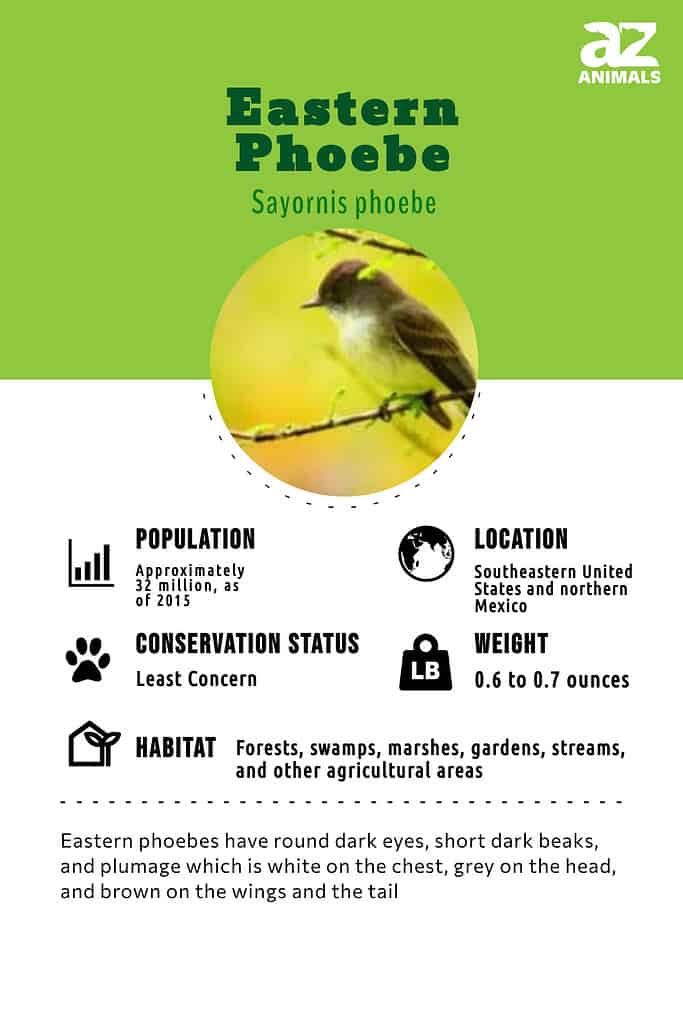
Eastern Phoebe vs. Eastern Wood-Pewee
Though the Eastern phoebe and the Easter wood-pewee are both members of the flycatcher family, they have a few qualities that make them easy to differentiate. The bill of a wood-pewee has a two-toned mandible, while the phoebe’s bill is entirely dark. Since they have similar coloring to their bodies, much of the difference is in their behavior.
One behavior is particularly notable – only the Eastern phoebe will wag its tail while perched. Their call is another obvious clue; while the phoebe is rather raspy, the wood-pewee has a call that is melodic and whistled.
Amazing Facts
- The name “phoebe” may come from the symbolism associated with the Roman goddess of the same name.
- The flycatcher family is known for its own symbolism – diverting and deceiving enemies. The phoebe specifically is symbolic of hidden knowledge and wisdom.
- Eastern phoebes are incredibly friendly, though they primarily keep to themselves.
Where to Find Eastern Phoebe
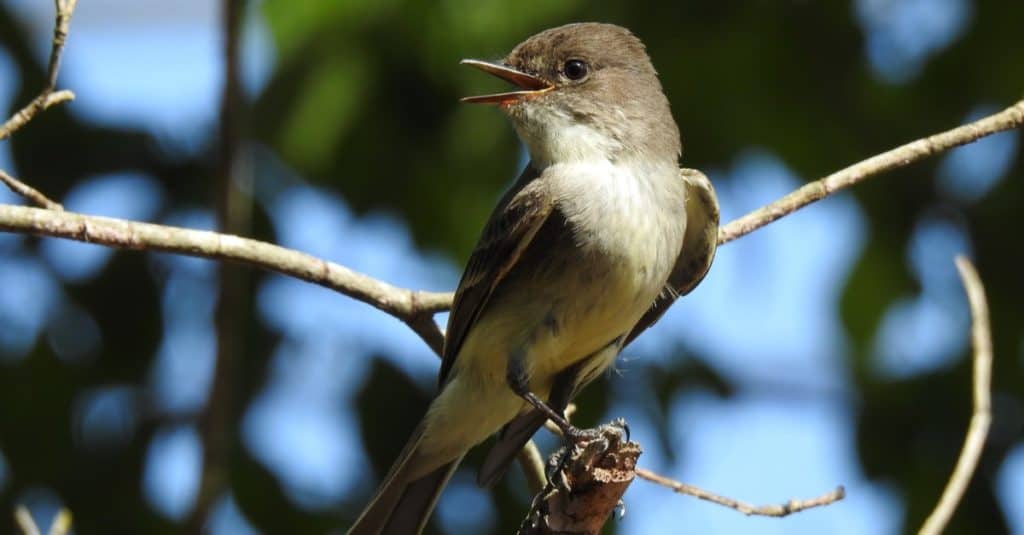
Eastern Phoebes generally live in the South including states such as Virginia, North Carolina, and Tennessee.
©Kireina/Shutterstock.com
The only states that they can typically be found in throughout the year are Virginia, North Carolina, and Tennessee. They are also found in some parts of Texas, Oklahoma, South Carolina, Georgia, and Arkansas throughout the year. Don’t worry – the Eastern phoebes are notorious for returning to breed by the early spring, though some will even return by the start of March.
The easiest way to attract Eastern phoebe is to offer a nesting box or other areas to perch.
Nests
These birds like to build a nest in areas with plenty of support and overhead protection, often looking for barns, a nesting box, or another manmade structure. They also build near streambanks and rock outcrops. Males will sing their brief two-part song around this time, while the female builds the nest or nesting box from leaves, grass stems, moss, mud, and animal hair. They are one of the few animals that will keep their nest up and return to it each time they have another brood.
If a male has two mates, he will alternate between two nests to help with the care and protection of the young.
Scientific Name

Eastern Phoebes belong to the Tyrannidae family and are also Passerines
©Elkin Restrepo/Shutterstock.com
The common scientific name of these birds is “Sayornis phoebe.” It belongs to the Tyrannidae family under the Aves class.
The genus name – “Sayornis” – is a combination of the name that Charles Lucien Bonaparte chose for the Say’s phoebe (“Muscicapa saya”) and the word “ornis,” which means “bird” in Ancient Greek. The use of the word “phoebe” has been a credit to the noise that the male makes, though it may also be named for the symbolism of Roman moon-goddess Diana (a.k.a. Phoebe).
Appearance
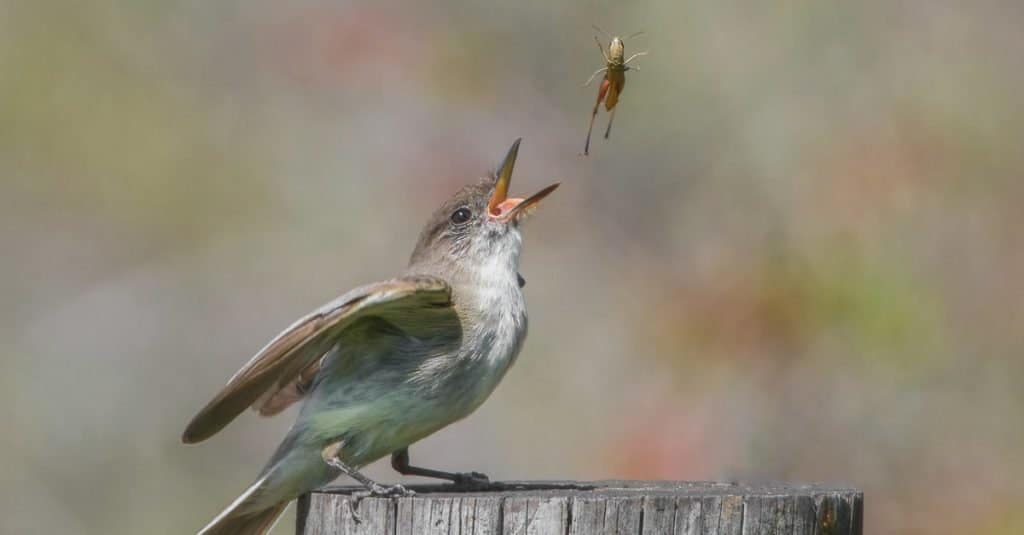
Eastern phoebes generally weigh 0.7 ounces at the most
©Chase D’animulls/Shutterstock.com
These birds have a brownish-gray back with an off-white underbelly. Their beak is short and thin, accentuated by a dark hue. Their wingspan can reach up to 11 inches, though their entire length is about 6 inches while they generally weigh between 0.6 to 0.7 ounces.
Evolution
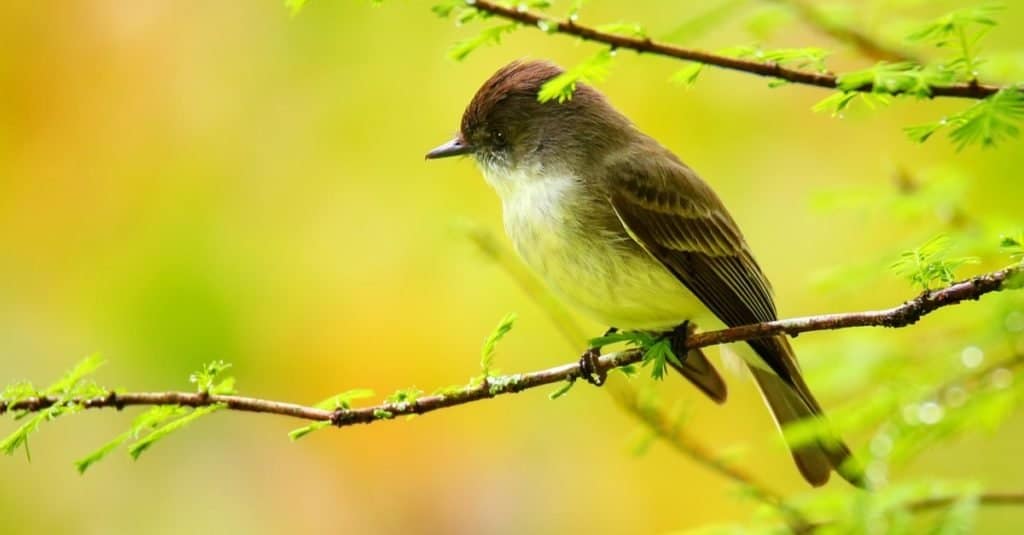
Eastern Phoebes are related to songbirds and New Zealand wrens
©Don Mammoser/Shutterstock.com
Eastern phoebes belong to the suborder Tyranni and as a result, are Passeriformes. Hence, they are also related to New Zealand wrens, which belong to the suborder Acanthisitti, and songbirds which belong to the suborder, Passeri.
The suborder eastern phoebes belong to is the most varied of the three groups, containing 5,158 species. The Passeri comes next with a total of 1,356 species. The Acanthisitti is the least varied with just 4 species. A glimpse at the history of this wide, varied family reveals it first came on the scene about 50 million years ago.
The Acanthisitti was the first to diverge while the Passeri and the Tyranni separated later.
Behavior
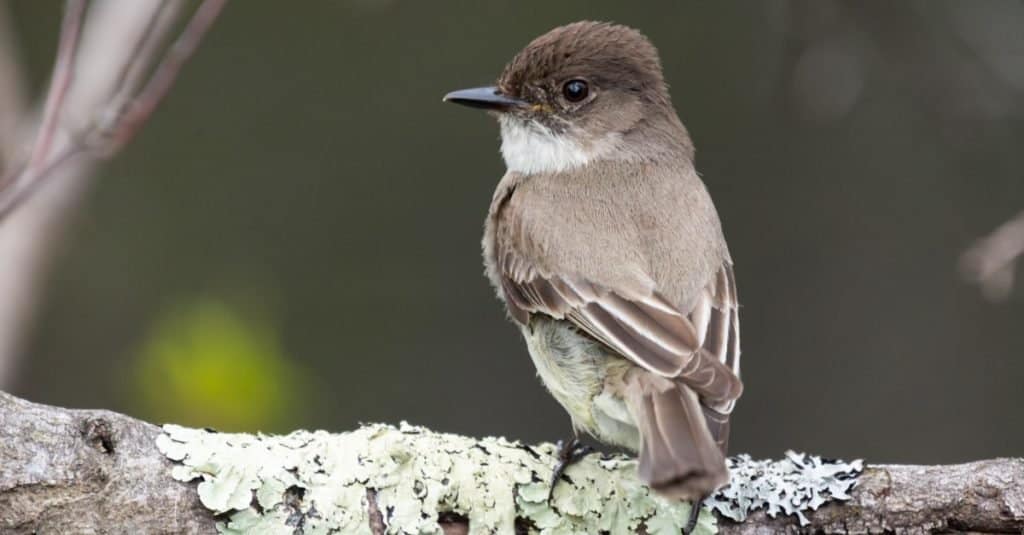
Eastern Phoebes migrate southwards between September to November
©Jeff Carpenter/Shutterstock.com
Even with the Eastern phoebe mates, they primarily remain solitary birds. They won’t spend much time with their mate, and they will hunt from the same branch. Though they periodically fly after insects, they like to find a safe home and stay there.
Migration Pattern and Timing
If you want to get a glimpse of these birds, you’ll need to consider their migration. From September to November, they seek out a reprieve from the cold weather as they follow the migration of the species to Mexico and the southeast United States.
In the springtime, sometimes as soon as March, the passerine bird will fly north to breed and create nests.
Diet
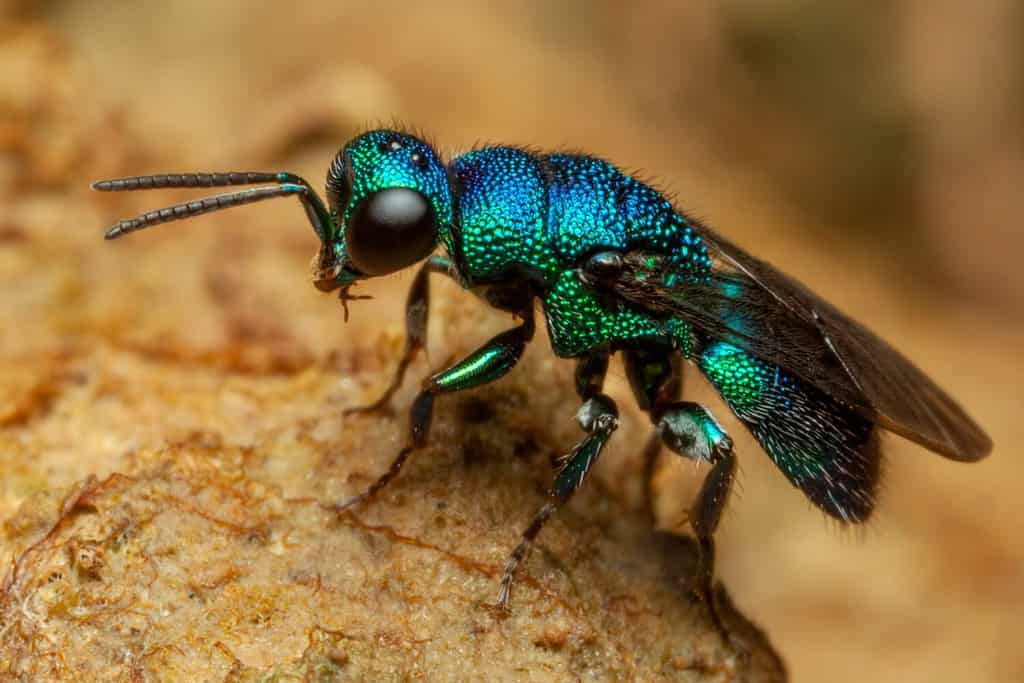
Wasps, grasshoppers, and millipedes are some of the Eastern phoebe’s favorite foods
©Chui Wui Jing/Shutterstock.com
As the Eastern phoebe perches on branches, it keeps a watchful eye and twitches its tail as it looks for insects to feed on. Most of the prey they catch is mid-air, though they don’t have to fly for long distances. They will go right back to the same branch while they wait for their next bite, and will hover as they pick at seeds and small fruits.
What does the Eastern phoebe eat?
The diet of this bird is primarily comprised of insects (like wasps, spiders, grasshoppers, bees, millipedes, ticks, seeds, and foliage.
Predators and Threats
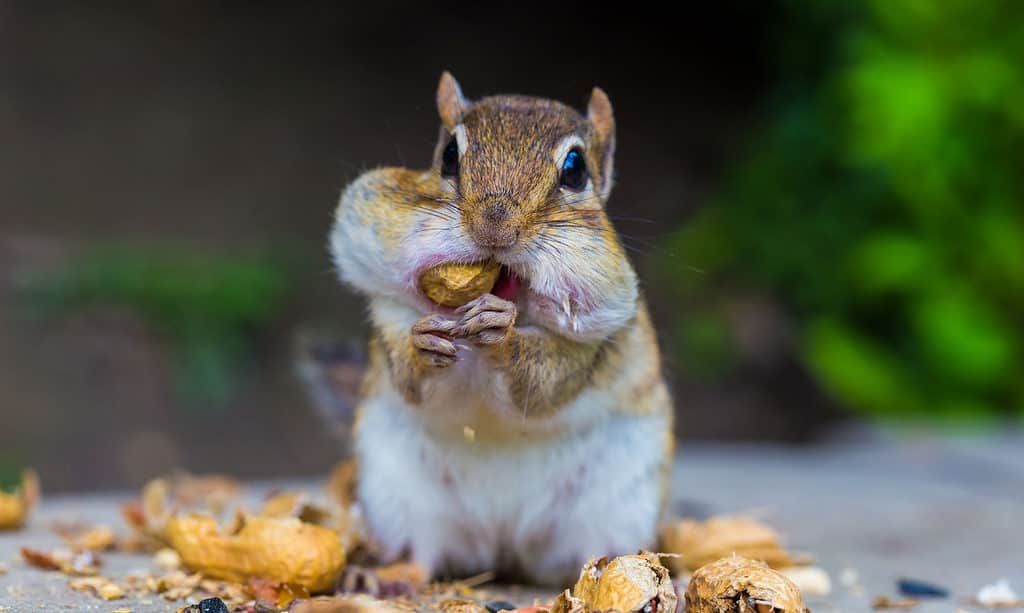
Chipmunks like mice and snakes, are fond of eastern phoebes’ eggs
©colacat/Shutterstock.com
Little is known about the predators that hunt the bird, though their eggs are at great risk. Predators like chipmunks, mice, snakes, and other birds will go after the eggs in their nest. Primarily, the female will try to defend the nest from these predators, but the male will also protect his family.
One of the great threats to this species is the brown-headed cowbird, but not because of hunting the Eastern phoebe. Instead, it will take the eggs from the nest of the phoebe and replace them with their eggs. The Eastern phoebe continues to take care of the eggs as if they are their own.
Reproduction, Babies, and Lifespan
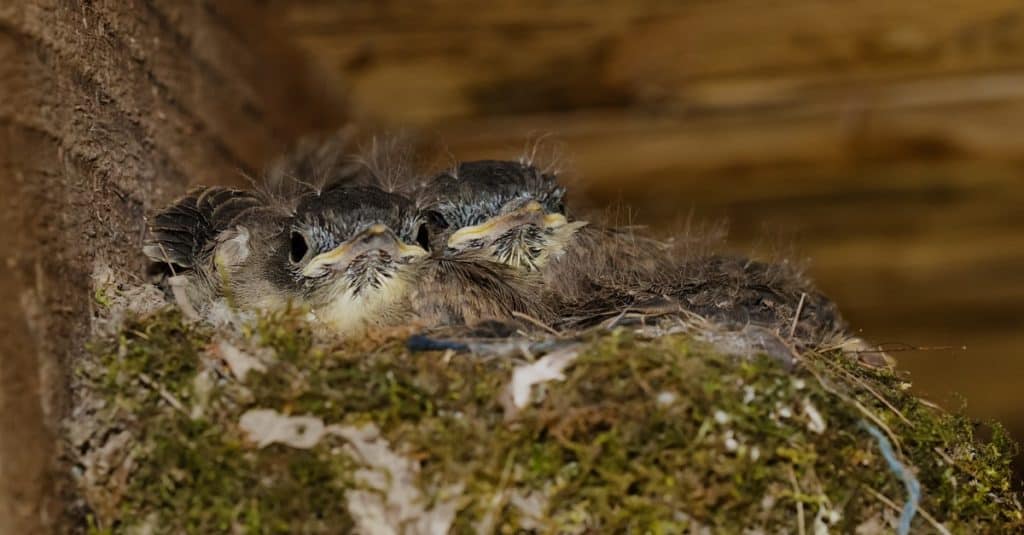
Eastern phoebe chicks receive about two weeks of maternal care before they leave the nest
©Paul Reeves Photography/Shutterstock.com
During the breeding season, the bird molts its juvenile feathers for the first time, finding a monogamous mate. Once the birds build a nest, their clutch will range from 2 and 6 eggs. The female primarily cares for the nestlings for 16 days before they leave the nest.
Population
The IUCN considers these birds to be of least concern since there are over 32 million of these passerines in migration at any given time. There are no conservation efforts currently being made, though some states will band the animals to identify them for research.
View all 117 animals that start with EEastern Phoebe FAQs (Frequently Asked Questions)
Does the Eastern phoebe migrate?
Yes. Typically, the migration pattern of the Eastern phoebe leads the species southward during September, October, and November. They settle in the southern United States and Mexico. However, they are one of the first groups of migratory birds to return in the spring when they breed.
How fast does the Eastern phoebe fly?
While the flight of the Eastern phoebe can be quick, no researchers seem to have recorded their exact speed. However, birds with similar bodies can fly approximately 34 km/hour.
What is the Eastern phoebe’s wingspan?
The short wingspan of the Eastern phoebe is 10.2 to 11 inches.
When do Eastern phoebes leave the nest?
The young of Eastern phoebes will typically stay with their parents in the nest for about 16 days after they hatch.
Do phoebes reuse their nests?
Yes. When the phoebe is not reusing their own nest, they may be left behind for barn swallows to use.
Is an Eastern phoebe a flycatcher?
Yes. The Eastern phoebe has a short and thin bill, which is the perfect size for tracking down and capturing insects to eat.
Are Eastern phoebes rare?
In some areas of the world – like Western Europe – it is rare to see Eastern phoebe. During the winter, they are fairly common in the United States and Central America.
How many eggs do eastern phoebes lay?
The average clutch size of Eastern phoebe will range from 2 to 6 eggs.
What does an Eastern Phoebe sound like?
The male Eastern phoebe has a two-part song with a minimal range that makes the same sound as their name “fee-bee.” The song is a brief moment, but it is rather raspy and sounds somewhat like they are stuttering through the word.
Thank you for reading! Have some feedback for us? Contact the AZ Animals editorial team.
Sources
- All About Birds, Available here: https://www.allaboutbirds.org/guide/Eastern_Phoebe/lifehistory
- Wikipedia, Available here: https://en.wikipedia.org/wiki/Eastern_phoebe
- Audubon, Available here: https://www.audubon.org/field-guide/bird/eastern-phoebe
- Animalia, Available here: https://animalia.bio/eastern-phoebe
- What Bird, Available here: https://identify.whatbird.com/obj/682/_/Eastern_Phoebe.aspx
- Oiseaux Birds, Available here: http://www.oiseaux-birds.com/card-eastern-phoebe.html
- Bio Kids, Available here: http://www.biokids.umich.edu/critters/Sayornis_phoebe/
- Exploring Birds, Available here: https://www.exploringbirds.com/posts/how-to-attract-eastern-phoebe

















